HOW PORTUGAL INFLUENCED INDIAN CUISINE
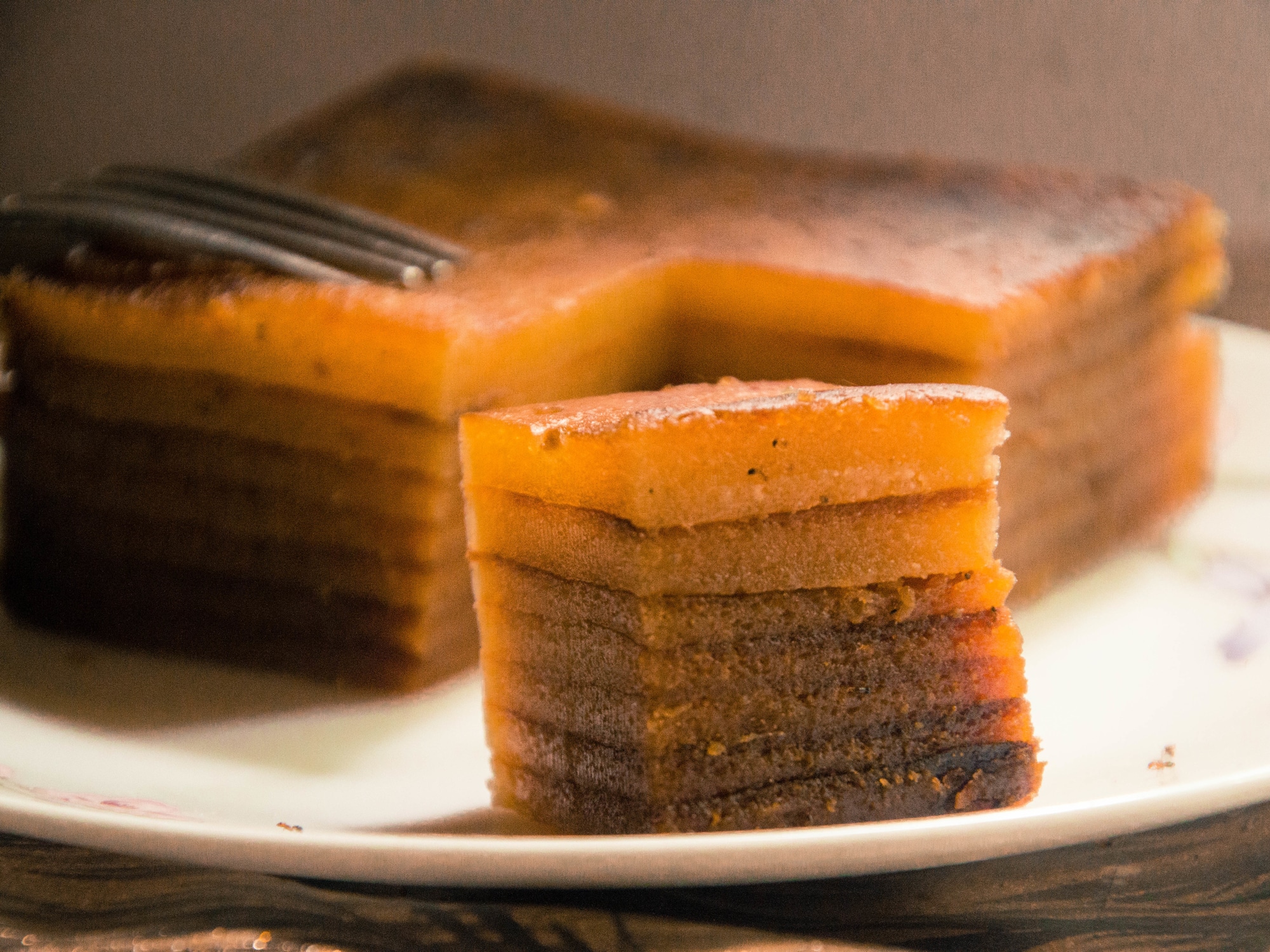
What’s the link between Portuguese and Indian cuisines?
It’s a well-known fact for those interested in the history of world foods that Portugal, and more specifically the Portuguese explorations, were crucial to help shape some of the world’s most renowned cuisines. With some exceptions, Portuguese cooking traditions didn’t per se influence cooking habits in other corners of the globe all that much. It was more that Portuguese trade was responsible for introducing new ingredients from far away origins, which eventually became defining staples of certain cuisines.
Amongst the world cuisines which the Portuguese have influenced the most, we find Indian cuisine. Would we even be able to picture Indian cooking today without such widely used ingredients like tomatoes, potatoes and, the most relevant of them all, chilies? These are some products brought from the Americans that the Portuguese introduced to India, mostly via the territory of Goa. But of course this exchange wasn’t linear nor one-sided and the mixing of cultures, cooking traditions and eating habits was way more elaborate than that, against an interesting, complex and often even grotesque historical background.
Portuguese arrival to India: spice trade, colonialism and the clash of cultures
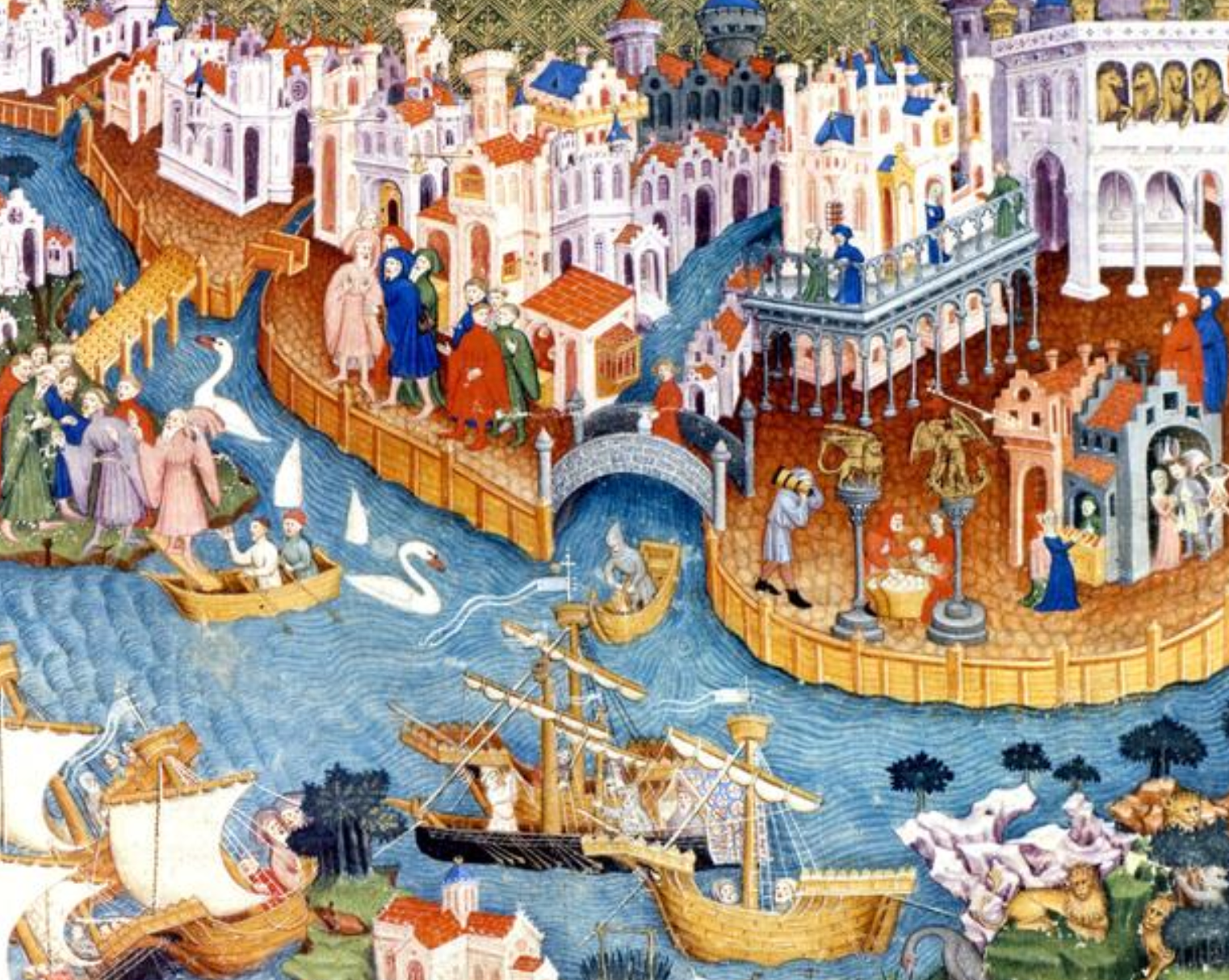
A view of Venice in 1338
Portugal’s first direct contact with India came about in the very late 1400s, when the Portuguese took an interest in the highly prized variety of spices coming from the Indian Subcontinent. Portugal wanted to take a part and potentially dominate the far Eastern spice trade, which was until that moment in history dominated by the Middle Easterners and the Ottomans. Much sought after spices such as cinnamon, clove, black pepper, amongst others, were back then making way to Europe via the Venetian trade, as Venetians would trade with the Arabs who had more direct access to the Indian territory.
During the reign of King Manuel, the first Portuguese voyage to India was organized, having been sponsored by the realm itself. This was when Vasco da Gama was selected to lead the expedition, which departed Europe on the 8th of July of 1497. Even though Vasco da Gama went on to eventually become one of Portugal’s most famous historical names abroad, his task was to follow the route to the Indian Ocean which had previously been partially explored by other Portuguese navigator, Bartolomeu Dias, who some years prior had already managed to reach the Cape of Good Hope, at the bottom of South Africa.
Vasco da Gama departed to India with supplies to maintain him and his crew for several years, as well as products that could potentially be used as trading goods, to negotiate their passage through strategic points. But trading tactics and diplomacy aside, this sailing trip was tremendously challenging, as a big part of da Gama’s crew ended up sick with scurvy, due to the lack of access to fresh food rich in vitamin C while aboard. With determination and, let’s face it, not observing what would have been basic workers’ rights today, the trip went on and da Gama’s fleet managed to sail around the testing Cape of Good Hope, eventually moving past South Africa towards the Indian Ocean, a territory never before explored by the Portuguese.
At the beginning of 1498, the first anchorage of da Gama and his crew in the Eastern coast of Africa was in Mozambique, which did years later become a Portuguese colony and which ended up being, as we will explore below, decisive for the embracing of Indian foods in mainland Portugal until today.
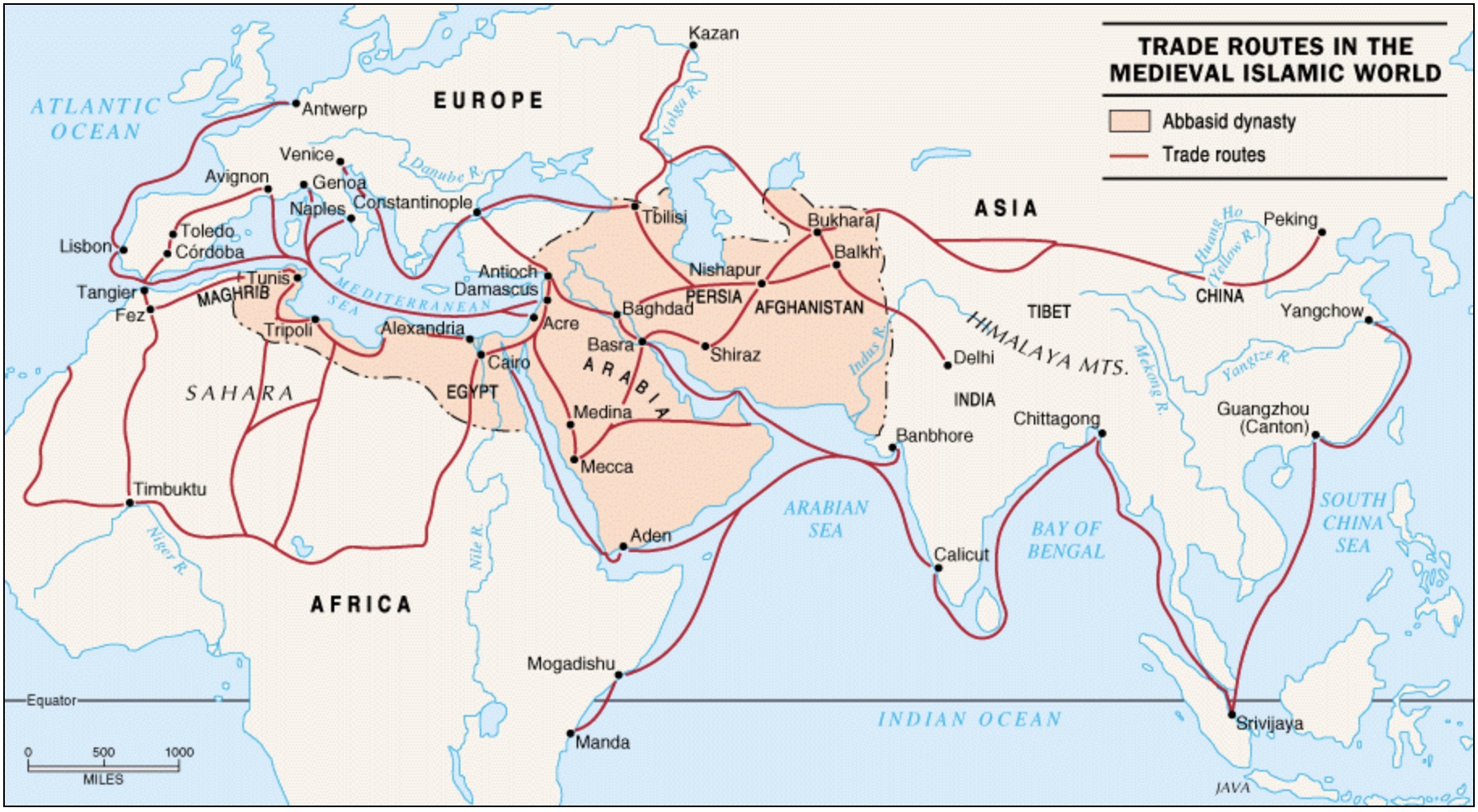
The Islamic world was embedded in a network of trading connections extending from the Atlantic to the Pacific. Copyright © 1995-2005, Pearson Education, Inc., publishing as Pearson Longman
Even before reaching India, the Portuguese were captivated by the rich and prosperous cities they’d come across in the Eastern coast of Africa. In due time, this fascination extended to India and even beyond towards Malaysia, Indonesia and China. The trade around the Indian Ocean was dominated by Muslims, who’d transport themselves and their goods in vessels with no arms, something that was unthought of for Mediterraneans, and speaks volumes of the way of approaching and dealing with new people in different corners of the world.
A critical approach to History
While Muslims had economic interests, we ought to admit that the Portuguese were also interested in wealth and power, but weren’t shy to assert this power and even climbing their way up to it thorough violence – a quick overlook of Portugal’s history with its ex-colonies, the destruction and deaths that have taken place throughout our history, is very representative of this and shouldn’t indeed be whitewashed.
Even though it isn’t rare for us Portuguese to be taught at school that Vasco da Gama’s expedition to India, and all the voyages during the Age of Explorations (circa 1500s) were acts of great courage, we way too often don’t focus on the negative aspects of these trips. For instance, as the arrival to India proved more taxing than expected, da Gama started stealing valuable goods (like gold and silver) from unarmed Muslim ships before he’d even learn how to trade directly with and from India and other nations along the Indian Ocean.
 Historians aren’t even sure if and how da Gama’s ships would have eventually made it to India if it weren’t for the Gujarati sailor which they’d met in Eastern Africa, more specifically in today’s Kenya, and who was crucial to show the expedition the maritime way to India, namely to the port of Calicut (now known as Kozhikode, in the south Indian state of Kerala), where the Portuguese managed to arrive about a month later.
Historians aren’t even sure if and how da Gama’s ships would have eventually made it to India if it weren’t for the Gujarati sailor which they’d met in Eastern Africa, more specifically in today’s Kenya, and who was crucial to show the expedition the maritime way to India, namely to the port of Calicut (now known as Kozhikode, in the south Indian state of Kerala), where the Portuguese managed to arrive about a month later.
The first time the Portuguese made it to India, they managed to do some trade in the hindu kingdom of Calicut, where they were allowed to trade paying taxes just like anybody else. After a few months of fairly unexciting trade, da Gama returned to Portugal with enough spice as to arouse the interest and greed of the Portuguese crown, who could anticipate great profits if further trade was to ensue.
After da Gama was received like a hero in Portugal, it was Pedro Alvarez Cabral’s turn to sail towards India, not only with the goal of being able to do further trade in Calicut with more beneficial terms (even if that meant acting by force) but also to conquer the most strategic points along the coast of Africa and, if possible, even take charge of other merchant ships they’d encounter on the way, in order to seize the valuable spices and other goods that they would be already carrying. Not only were the Portuguese returning to India with big commercial plans, they were also bringing a group of Franciscan friars along, to try and convert Hindus to catholicism while at it.
Alvarez Cabral got way off route during his trip to India and ended up in the coast of Brazil, which did later also become a major commercial interest of Portugal and eventually even a colony. This happened in 1500 when Columbus and his Spanish fleet had reached Latin America only a few years prior to that, in 1492, asserting their dominance over most of the central and south American territory. After some time, Alvarez Cabral’s trip onwards to India was resumed and the Portuguese were once again in Calicut, where they managed to strike a commercial treaty with the local king, flattered by the luxurious gifts the Portuguese had this time brought with them from Europe. The Portuguese were even allowed to set up their own spice processing factory in Calicut but had to eventually move to other parts of the Indian west coast after they tried to seize a Muslim merchant ship and the Muslims retaliated by bombarding Calicut.
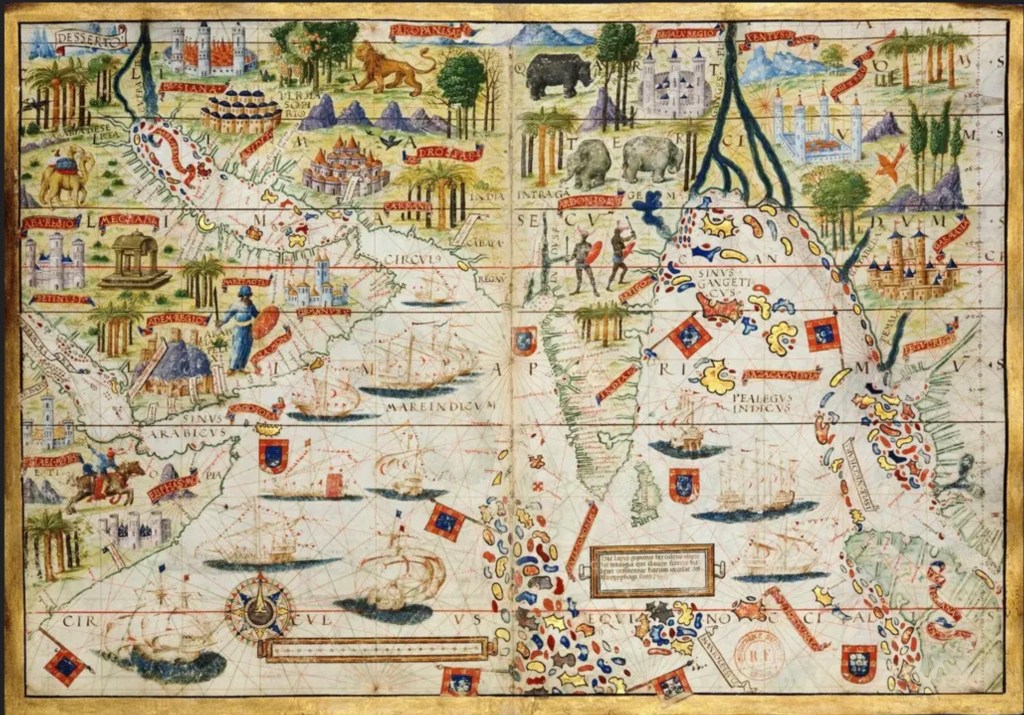
Indian ocean commerce. A piece of the Portuguese Atlas Miller, 1519, ordered by King D. Manuel (the original can be seen at Bibliotèque Nacionale de France).
After some time in Cochin, on the Malabar Coast, Alvarez Cabral returned to Lisbon with enough quantities of spices to destabilize the long established Indian-Arab spice trade. This is when the Portuguese thought of India not only as a place where to do trade but as a potential Portuguese territory abroad. And so Portugal felt it was its right to appoint Francisco de Almeida as the first viceroy of Portuguese India, giving him the mission of once and for all establish Portuguese control along the most important points along the African coast, until then dominated by the Arabs, and rule a part of India where to do trade with no limitations. With a troop of 15.000 men, de Almeida had enough manpower to take over 1000 km of African coast, leave some of his man behind to keep control of these territories, and after intense warship with the Muslims who had for a while controlled the trade in the Arab sea and Indian Ocean areas, with lots of bloodshed and countless deaths, managed to imposed themselves as the new ruling force.
The Portuguese found that Goa, also on the Malabar Coast, was an ideal strategic spot where to establish a naval fleet used to protect their new trading empire and keep asserting their dominance in the region.
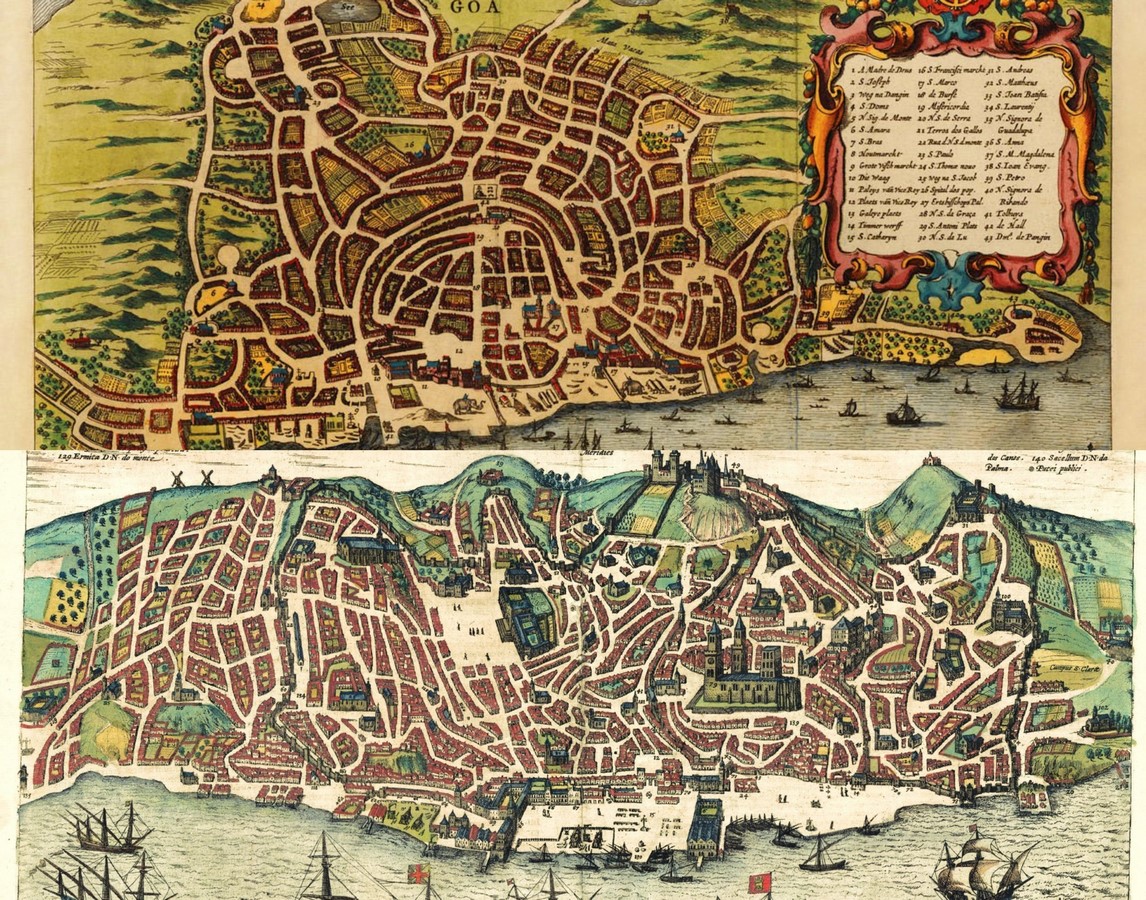
Comparison between Goa city (upper image) and Lisbon city (lower image) ©Historic City Center, Hebrew University
It was from here that the Portuguese were to further develop the spice trade in Asia, connecting onwards east to Malaysia and China, and back towards Europe, via sea and via land, through the Gulf, Egypt, the Red Sea, and from here entering the long-time familiar Mediterranean ocean (where trade could be furthered by selling Indian goods to the locally dominant Venetians).
At this point, the Portuguese rule of Goa in India, which was to last for 450 years, started.
Goa’s settlement planning draws similarities with Lisbon. Portuguese settlements were usually built on high ground, one of the defensive strategies known as the Castrensian tradition (Pre-Roman period). Portuguese towns, like Lisbon, were built in such a way that they fitted the land’s topography. The Indo-Portuguese settlements were no exception.
These settlements were frequently separated into two tiers. The port and other commercial operations were placed on the lower level, while the administrative buildings, institution buildings and residential structures were located on the upper level. Churches were strategically located in the heart of uptown to serve as a linking point between uptown and downtown. The whole settlement resembled a semi-circular arch, with the main roadway connecting the upper and lower parts of town.
Today Goa architecture represents one of the biggest interests in the city, reflecting not only the Portuguese colonial power and control but also local Goan characteristics, which together gave birth to a new hybrid architectonic style. Something that can also be seen and tasted in food!
How Portugal contributed to the repository of Indian foods
The Portuguese presence left a mark on Indian food in two distinct ways.
On one hand, and little by little, the Portuguese introduced new ingredients to the entire Indian subcontinent. These were products which were coming from other corners of the globe where the Portuguese were also establishing themselves during the Age of Explorations, namely from the Americas as well as several parts of Africa – even though most African origin ingredients we find in India today (like okra and tamarind, for example) had already been introduced during the earlier Arab-Indian contacts.
On the other hand, certain dishes and cooking techniques were brought over to India by the new Portuguese inhabitants who’d cook food the way they’d know how to, reminiscent of home, yet often having to make the most of local ingredients. As these would in many cases differ, long established traditional Portuguese dishes were adapted with the use of local products, eventually to local palate and, in due time, evolved to be brand new Indian recipes with Portuguese inspiration. This was something that didn’t quite influence the entire subcontinent but, instead, the regions dominated by the Portuguese: mostly Goa, and nearby Daman and Diu.
Most popular ingredients the Portuguese introduced to India
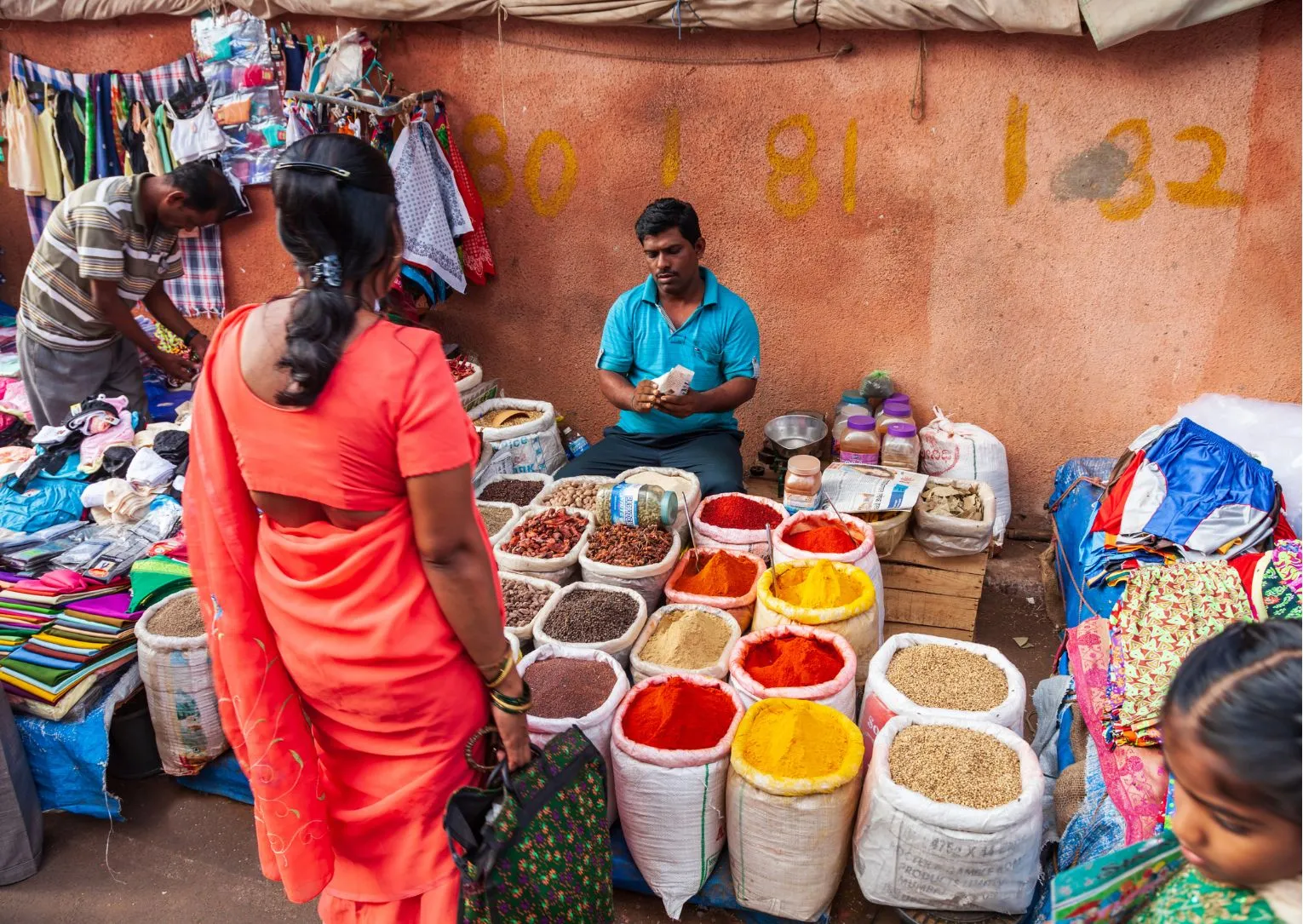
Goan food market
Chilies. Tomatoes. And potatoes. This is a trifecta of ingredients that is at the base of so many Indian dishes which are beloved worldwide today. Think about butter chicken, aloo gobi, bhindi masala, and even tikka masala (which even though it’s universally associated with Indian origins, it is a recipe which was actually developed in Glasgow, Scotland, by a sub-continental cook- we’re not sure if Pakistani or Bangladeshi as the debate is still up – as recently as the 60s), amongst so many others! Just like Italian cooking didn’t include tomatoes until the 1500s, Indian kitchens were preparing heavily seasoned dishes for centuries, but it was only with the arrival of the Portuguese in the 1500s, that the cuisine defining heat of chilies was incorporated.
As the Portuguese established themselves in Goa, other European fleets were exploring different corners of the world, exploiting local resources for their own benefit but, while at it, also contributing to create what we nowadays refer to as a globalized world. The exchange between different continents took many shapes, but the trade of ingredients was certainly one of the most impactful ones for everyone involved.
Besides tomatoes, potatoes and chilies, other popular ingredients which the Portuguese brought over to India from the Americas, included: beans, corn, peanuts, cashews, guavas, pawpaw, peppers, pumpkin and squash. It’s worth noting that, even though the Portuguese were already establishing themselves in South America, more specifically in Brazil in the early 1500s, the Spanish dominated most of central and south America. As such, some of these ingredients were acquired (or simply taken from them?) by Spanish Conquistadors to Mesoamericans, sold to the Portuguese and brought over to Goa by them.
Vinegar began to be used to season various dishes, to make dressings, achaar (Indian pickles) and chutney. Neither Hindus nor Muslims used to cook with vinegar. The former, because it was made through fermentation of sura, extracted from the palm tree. The latter, perhaps for an identical reason, since the Koran prohibits the use of alcoholic beverages. Instead, for acidity, Muslims and Hindus favored tamarind, brindle berry (aka Malabar tamarind) and lemon juice. For curries, they also used green mango and, sometimes, bilimbi (Noronha, 2004, “Sabor de Goa”, Assírio e Alvim Editions).
Once again, all of this proves the point that there is no such thing as an “authentic” cuisine, as the concept of a cuisine that stays true to the essence of its place of origin is not only fairly subjective, but it is definitely ever-evolving according to the passage of time, variable socio-economic factors and even the climate-influenced availability of ingredients.
Indian foods which originated from traditional Portuguese recipes
While the Portuguese were rather well-succeeding introducing and imposing their culture (including catholic religious traditions) and sense of aesthetics (which can today still be appreciated in Goa’s undoubtedly Portuguese-influenced architecture), things weren’t as straightforward with food. If the new ingredients Europeans had sourced from the Americas and Africa were generally well received in India and the rest of Asia, the overall flavor profiles and cooking techniques were harder to charge. As such, most food inhabitants of Goa were consuming during the Portuguese rule was way more Indian than it was Portuguese.
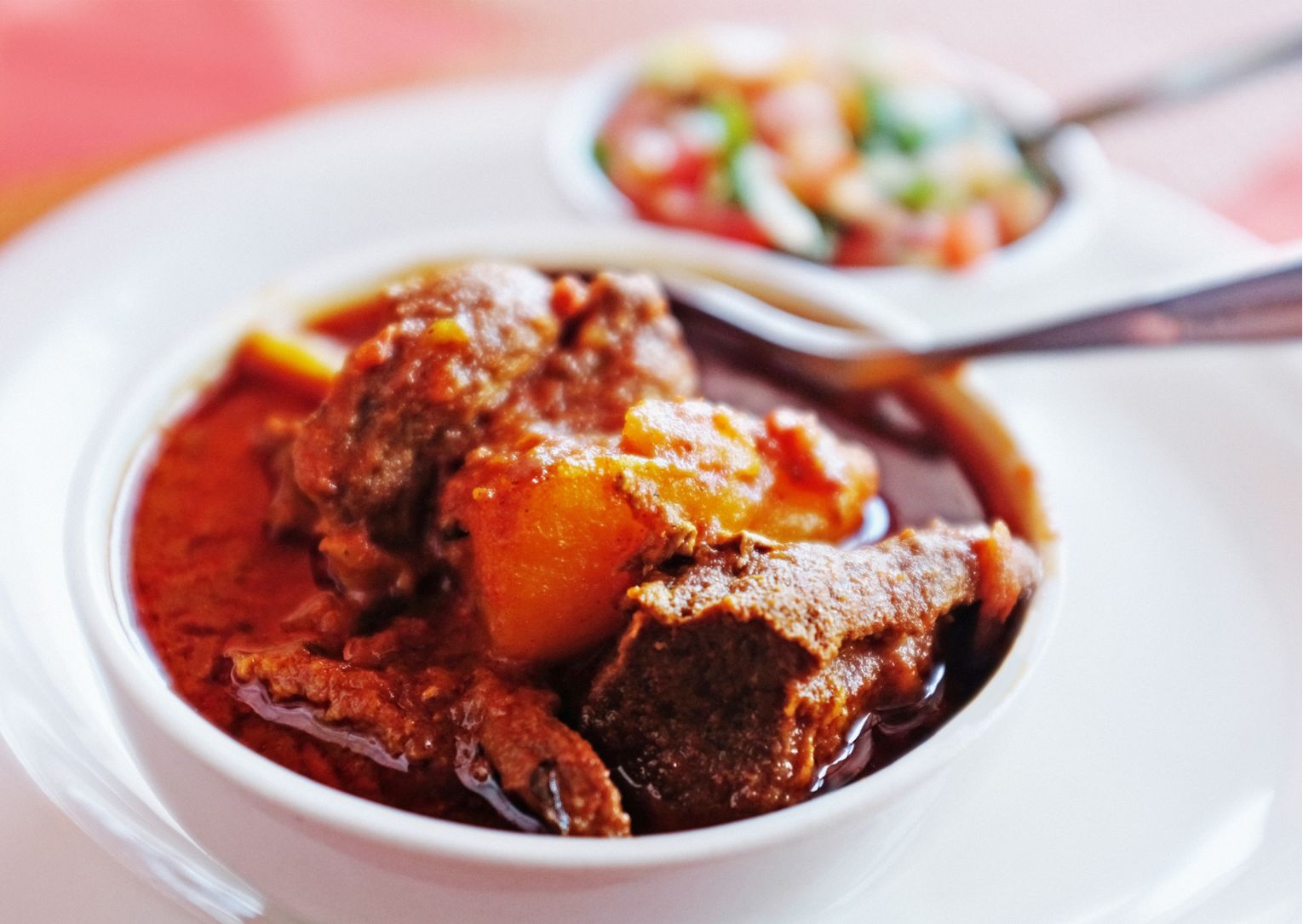
Goan pork vindaloo
Portuguese abroad did recreate their home-dishes to the best of their abilities considering the ingredients available locally. But the shortness of key ingredients and the curiosity of Goans to eat these foods, yet closer to the flavors they were more used to linked with the local Konkan cuisine, lead to the adaptation of Portuguese recipes and the birth of Portuguese-Indian cuisine.
One of the major impacts the Portuguese had around Goa was the generalization of meat products. If until then Indians were Hindu, in this region, because of Portuguese influence, the majority of the population had by then embraced christianity, which meant leaving behind a vegetarian diet. This is how meat, and in particular pork (also not contemplated amongst Muslims present in other parts of India), including blood and offal, became commonplace.
Wine was also first introduced by the Portuguese to India, even though when it came to cooking it was often replaced by palm vinegar, a much more broadly available ingredient around Goa.
Pão, or pav as it is still widely consumed in India today (not only in Goa but, for example, also Bombay, where some of the most representative street foods include pav bhaji – which only came about as “recently” as the 50s/60s – and vada pav, a sandwich of spiced potato patties stuffed inside a bun) became common. Pav is a fluffy yeasted bread, in contrast to the unleavened flat breads, such as roti and naan, more usually consumed across India for centuries. The popularization of pav in Goa was easy when the Portuguese first started baking it, as it didn’t even have to compete with other flatbreads, more popular in other parts of India which had been more heavily influenced by the Ottoman empire. In Goa, pav was to be consumed along with the local staple carbohydrate rice and, in some cases, even replaced it all together.
These and other foods brought over by the Portuguese were are the base of famous dishes of Portuguese influenced Goan food, which are still widely enjoyed today, more than 500 years after the Portuguese first reached India:
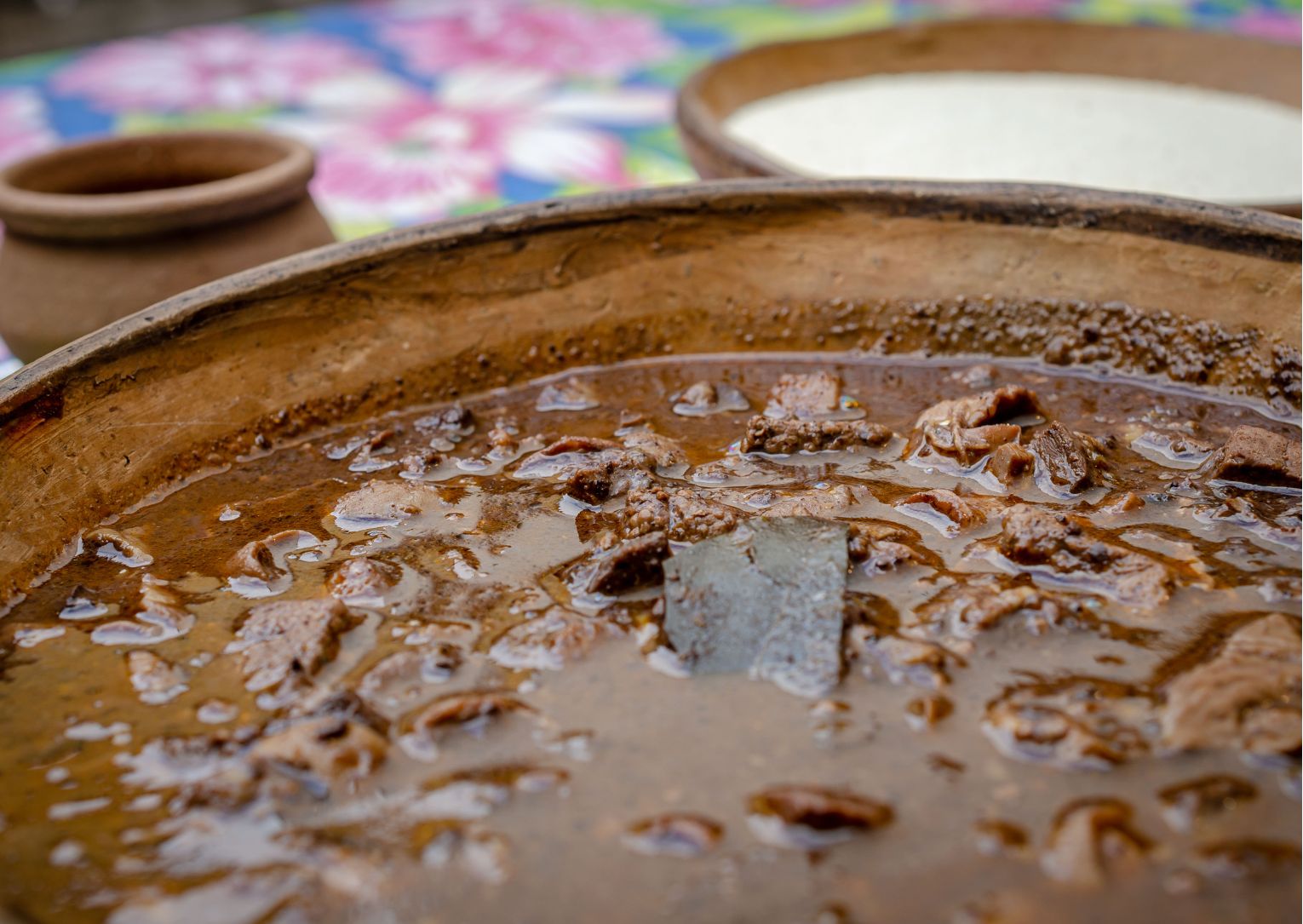
Sarapatel or sorpotel
When we think of Portuguese origin Indian dishes today, perhaps the most widely known example is vindaloo. This popular curry in India and in lots of Indian restaurants abroad, is a part of the so-called Goan Catholic cuisine, which is to be distinguished with Goan Hindu cuisine influenced by the rest of India, and which is mainly pescetarian and lacto-vegetarian. Vindaloo had its inception in Portuguese vinha d’alhos, a typical marinade of vinho (wine) and alhos (garlic) usually applied to meat. When the Portuguese brought vinha d’alhos (also known as vindalho in India still today) the usual red wine was quickly substituted by vinegar from palm trees which was way more readily available, and layers of flavors were added with the local spices, which also helped preserved the meats used (mostly pork) from the effects of the hot weather during the age of no refrigeration. Vindaloo, just like the vinha d’alhos consumed by sailors on their voyages from Portugal to India, was as much a dish as it was a food preservation method. If you come to Portugal, we’d highly encourage you to try carne de vinha d’alhos (which you are more likely to come across in Madeira islands or a Madeira themed restaurant in Lisbon) to compare it to vindaloo and taste the evolution and metamorphosis of this dish.
The use of pork around Goa also materialized in the recipe of sarapatel, or sorpotel, still common in the coastal Konkan region going from Mangalore through Goa. Sarapatel is a typical recipe from the Portuguese Alentejo region, prepared with pork, offal and even the animal’s blood, cooked with a variety of spices, becomes quite different from that of Iberian Peninsula and its Atlantic extensions. Vinegar is also added to prevent the blood used during the cooking process to coagulate, just like it does in traditional Portuguese cooking, in other dishes such as sarrabulho (pork and blood stew) or cabidela (braised chicken rice with its own blood).
Preservation techniques were (and still are) also applied to seafood. Goan para, pickled fish with jaggery (unrefined sugar cane consumed in Asia and Africa) and vinegar marinade is one example of this, reminiscent of Iberian escabeche, which in its turn was an inheritance of the Moorish occupation in Portugal and Spain, and which curiously went on to inspire nanban zuke (fried fish with vinegar, which literally translate as southern barbarian marinade) when the Portuguese later reached Japan in 1543.
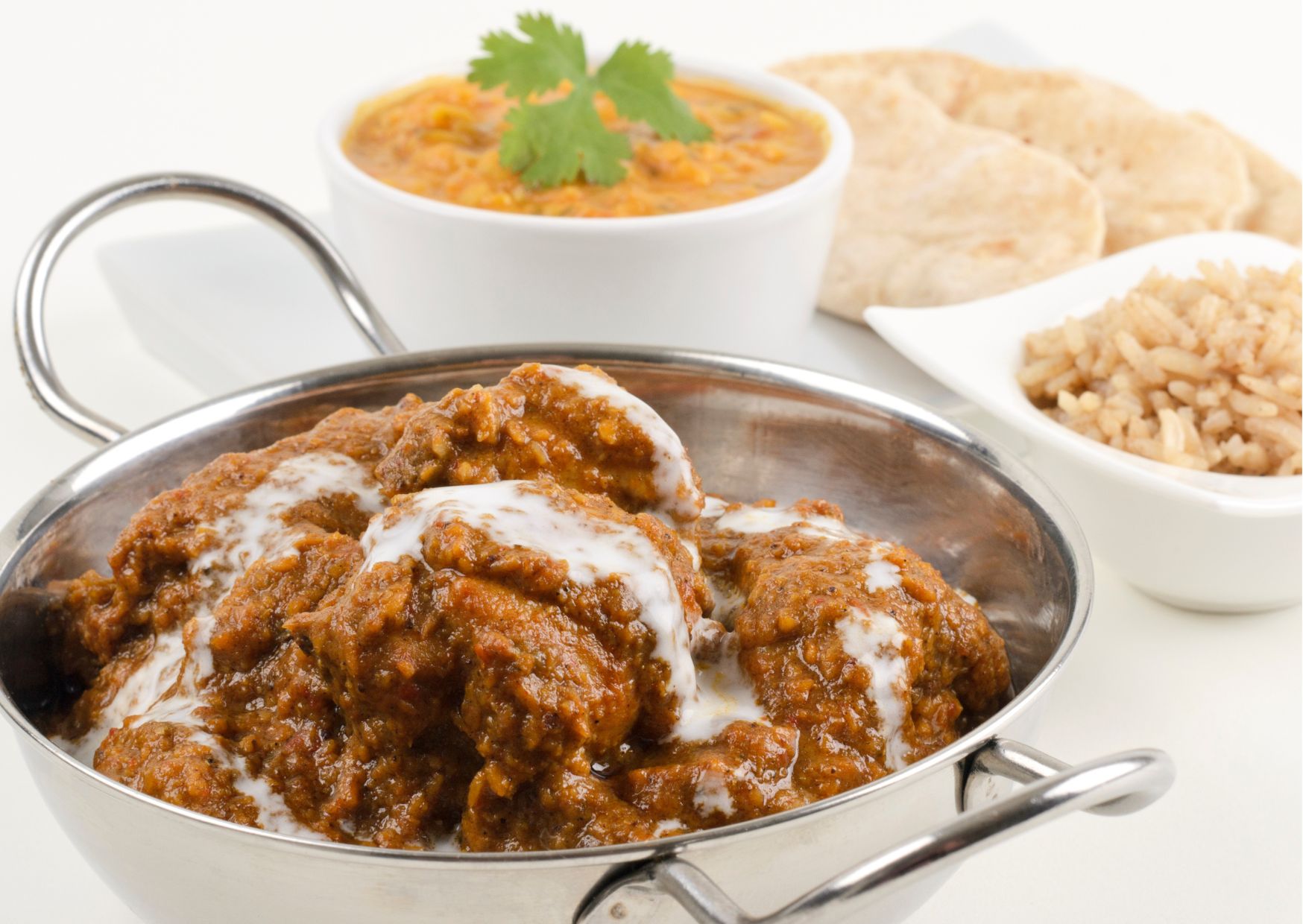
Xacuti or ‘chacuti’
Colonizers who came to Goa for trade brought with them recipes but also food preservation and cooking techniques. Goan sausage, derived from Portuguese chouriço, is one such example. Pork meat was cured to last during the voyages that took the Portuguese to Goa and back to Lisbon, but was also, and still is, appreciated locally. Of course Goan sausage (also known as chorise) packs more heat than your average Portuguese chorizo, but that’s expected by now after exploring how the previous dishes we’ve looked into evolved from their original Portuguese recipes to their Indian counterparts.
Xacuti, or chacuti, is a succulent curry prepared with a mix of spices, coconut, and variable animal protein which could include chicken, goat or even beef. But how does something that seems so Indian (including chilies, coconut and spices like nutmeg, curcuma and cardamom) have anything to do with Portugal? This is a curious case as if you ask around Goa, popular knowledge will point towards Portugal as the origin of chacuti, while here in Portugal it is widely regarded as a Goan speciality. This leads us to think that this was probably a dish which indeed originated in Goa (as explained by the use of local ingredients) yet it did so during Portuguese rule, and included animal proteins which wouldn’t have even been considered prior to the catholic influence on the local hindu majority which made up the masses until then.
Other notable Portuguese influences in Goan cuisine can be pointed out, if not because of the use of ingredients or cooking techniques, because of the current dish names which have clearly derived from Portuguese language. One clear example of this is Goan recheado (recheado means stuffed in Portuguese), which applies to anything stuffed, usually fish. Of course the spicy and tangy recheado masala used to take a simple grilled fish to the next level has a very Goan seal of identity!
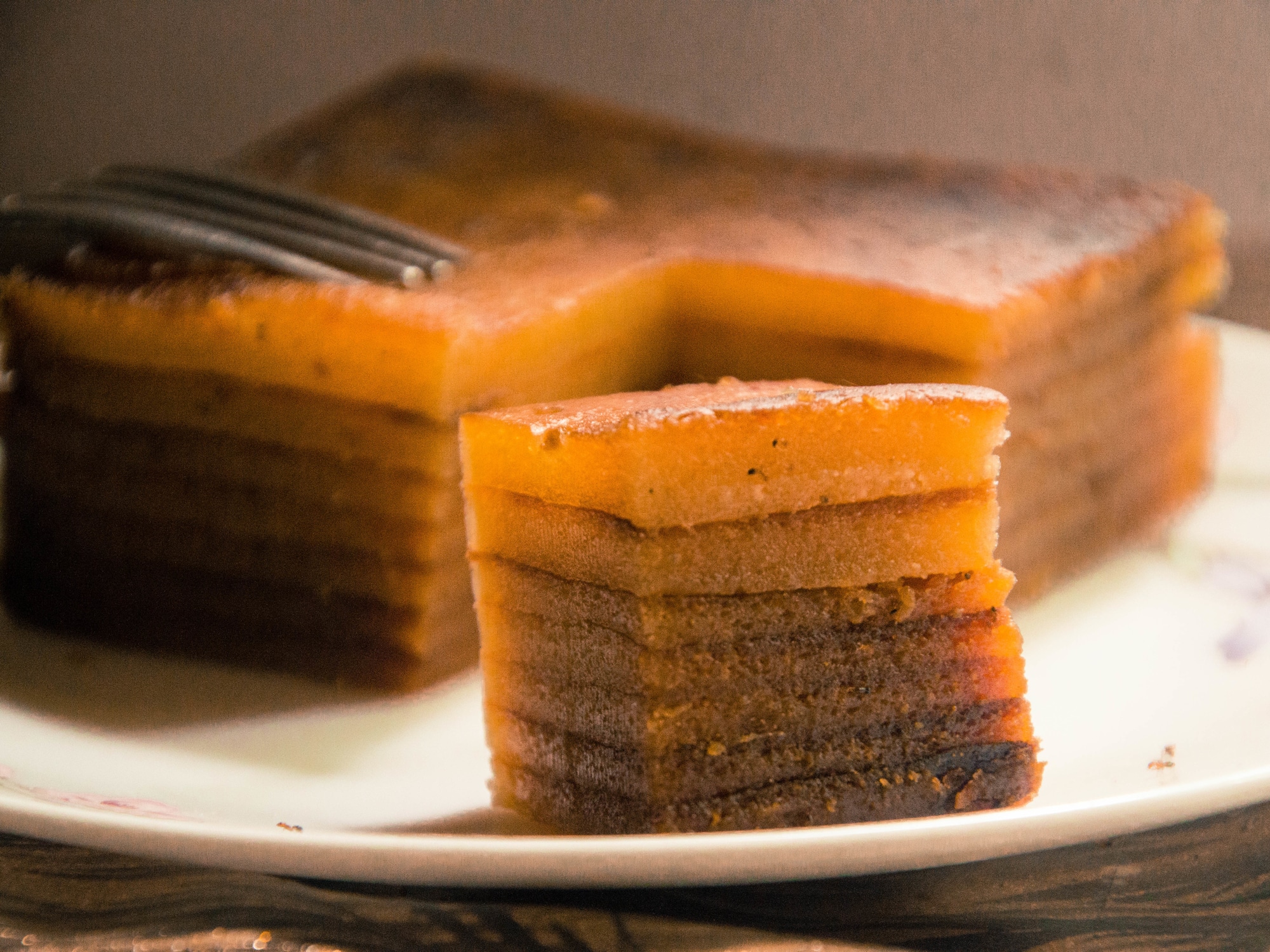
Bebinca (photo from cookbook.pfeiffer.net.au)
Portuguese influence might not have been as obvious when it comes to desserts, but you can indeed distinguish several typical sweets from around Goa from those in other states of India because of the use of eggs. Just like it happens with conventual sweets in Portugal, which are characterized by the large amounts of egg yolks in the recipes, we can observe bebinca as a good example of this. If it’s true that, these days, you are more likely to find bebinca in Goan restaurants in Portugal, more than in Goa itself, it was indeed first developed in Goa.
The origin of Bebinca is related with Lisbon seven hills. The story tells that a nun named Bebiana was transferred from the Mónicas Convent in Lisbon (not far from the Flee Market) to the Santa Mónica Monastery in Goa with then adapted the original Portuguese conventual dessert to the local specificities and to what was available. She replaced the cow’s milk with coconut milk and the almonds with coconut, adding flour, sugar, clarified butter. She then cooked it with seven layers, recalling the seven hills of Lisbon, analogous to the seven hills of the old city of Goa.
This eye-catching dessert, it is the one we’d recommend the most for you to try if you visit one of the best Goan restaurants in Lisbon and expect to find Bebincas consisting of more than just seven layers (up to 16!).
Because with good food there ought to be good wine (indeed a very European habit the Portuguese weren’t ready to give up while in India), they started planting vineyards around Goa. Even today, India’s humble wine production mostly happens around Goa, notably because of the appropriate weather and topography, but mostly because of the actual historical influences from the Portuguese. Besides table wines, Goa still produces a sweet fortified wine mimicking Port (such as the one by brand Vinho Fontainhas), which is not as every-day as it could be here in Portugal, but that clearly shows how the Portuguese influences left deep marks in the local eating and drinking habits.
Was Portuguese influence only felt in Goan cuisine or did it extend to other parts of India?
To a large extent, Portuguese influence was felt mostly in the east coast of India, around Goa, Daman and Diu. After all, this was indeed Portuguese India. If the Portuguese were to influence other regions of India, it was already via Indians themselves. As such, the potential influence would already be diluted by the propagation of ideas within the Indian territory.
But, even if the example is almost anecdotal today, it’s interesting to note how the Portuguese still managed to have an impact on the opposite side of the country, namely in Bengal. The Portuguese had established a small settlement near Calcutta, where they produced Bandel cheese (after the name of the locality where they were living). Bandel cheese is made from cow’s milk, curdled with lemon juice and, even though it was introduced by the Portuguese, it was actually mostly produced by Burmese cooks under Portuguese supervision. Today, you can still find Bandel cheese in very specific places, even though it’s only currently being produced by a handful of artisans such as Palash Ghosh and his family.
Indian recipes which came from other Portuguese colonies
Not only was Indian cooking influenced by the habits and recipes the Portuguese brought over to India directly from the old continent, Indian cuisine was also marked by recipes from other places where the Portuguese were simultaneously trading with and establishing themselves at. As we explored above, this involved the use of new ingredients but, further than that, even the export of specific cooking techniques and recipes.
 Balchao, or balchão, is one such example of typical Indo-Portuguese recipe, which wouldn’t have happened had the Portuguese not reached Macao, now-a-days China, from where they brought over the concept of balichão. This is a typical fermented macanese sauce, prepared with chilies, bay leaves, salt, pepper, brandy and prawns, which was incorporated into Goa cooking, giving rise to prawn balchao.
Balchao, or balchão, is one such example of typical Indo-Portuguese recipe, which wouldn’t have happened had the Portuguese not reached Macao, now-a-days China, from where they brought over the concept of balichão. This is a typical fermented macanese sauce, prepared with chilies, bay leaves, salt, pepper, brandy and prawns, which was incorporated into Goa cooking, giving rise to prawn balchao.
Cafreal, usually chicken cafreal, was in its turn imported from Africa and eventually absorbed by the Indo-Portuguese cooking repertoire. This dish consists of pieces of chicken first shallow fried and then braised, after having been marinated in a rich concoction with chilies, spices, fresh coriander and vinegar or lime juice.
An example of a food that traveled across the world as a result of colonialism is the Dodol. A sweet, toffee-like confection, very laborious and time-consuming popular in Sri Lanka, and considered a heritage food of the Malay community, was most certainly introduced in Goa by the Portuguese.
Portuguese restaurants in Goa
Indo-Portuguese cuisine is very rich and certainly captivating. If you find yourself in Goa, we’d suggest you go explore some of the best Luso-Indian restaurants which prepare traditional Goan cuisine, such as Viva Panjim in Panaji, or Alfama in Dona Paula. Friendly warning: don’t be surprised if you order caldo verde in Goa and the iconic collard greens soup of Portugal is around here prepared with spinach instead!
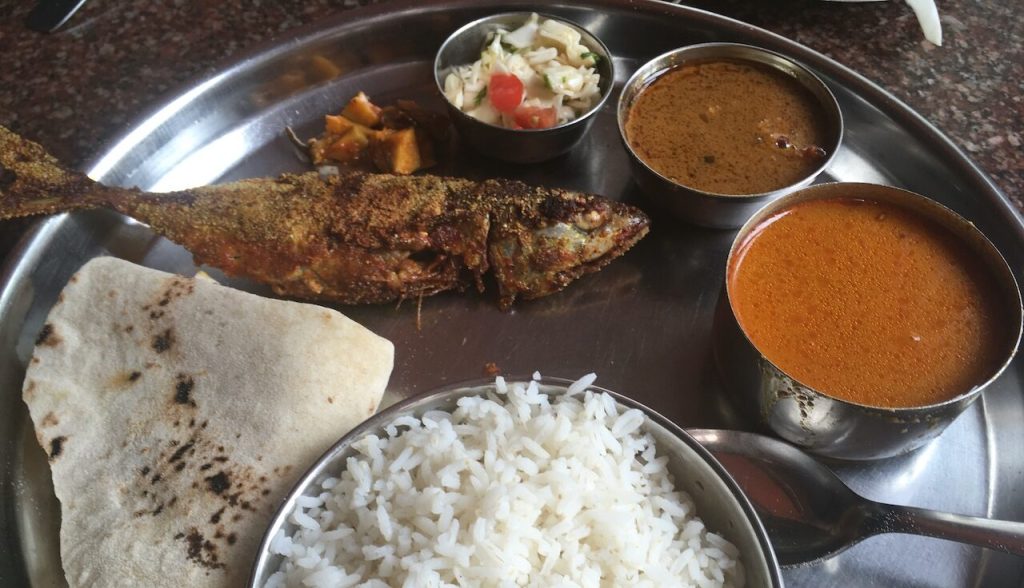
Fish Thali: one of the most typical dishes in Goa. Photo: Zara Quiroga.
Article by :
Zara Quiroga (freelance food writer and food & cultural leader at Oh! My Cod Pico Trips)
Want to more about Portuguese cuisine and its influences?
How India influenced Portuguese food
Pico Wine: one of the world’s most unique wine regions (Genesis – Part I)
Alentejo and Algarve: culinary traditions of the South of Portugal
10 Portuguese Codfish recipes step-by-step
Minho, Douro and Trás-os-Montes: the cuisines of Northern Portugal (includes Porto!)
